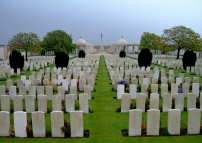| First Name: | Thomas James | Last Name: | HARRISON | |
|---|---|---|---|---|
| Date of Death: | 25/09/1915 | Lived/Born In: | Leyton | |
| Rank: | Gunner | Unit: | Royal Field Artillery 12 Battery 35 Brigade | |
| Memorial Site: | Loos Memorial, France | |||
Current Information:Age-23 58, Waterloo Road, Church Road, Leyton Born-Chiswick The Royal Artillery During the First World War some 800,000 British and Allied men served in the artillery, of whom nearly 50,000 were killed. They were a vital component of the army, used for a number of purposes but primarily to destroy the enemy’s defences before the infantry attacked. The artillery brigade was the equivalent of an infantry battalion with a complement of over 800 officers and men whereas the artillery battery, of which there were three to a brigade, numbered about 200 personnel. Within the ranks there were gunners and bombardiers, drivers, signallers and telephonists. At the beginning of the war when things were much more fluid, artillery batteries could find themselves in the front line of the action but as the war progressed and trench warfare became the norm, the batteries were placed behind the line and in the case of the Royal Garrison Artillery, which employed the big, heavy guns, often many miles back from the line. However this did not mean safety. The enemy would use spotter planes and other methods to determine the positions of the guns and these would then be targeted by their own artillery. When this happened there was little escape for the gunners. They had to keep firing their own guns regardless of what might be happening around them and there were many a direct hit on their emplacements, killing and injuring whole gun crews. Others would act as spotters which meant going forward to the front line and signalling back to the guns necessary changes in target and other vital information. Once in position, artillery brigades tended not to move much so whilst the infantry could be relieved at regular intervals and move back to safe positions, the men of the artillery stayed where they were for much longer periods of time. The Battle of Loos This was fought by the British Army from 25th September, 1915 through to 13th October, was conducted along a six-and-a-half-mile front running north from the mining village of Loos on the outskirts of Lens in Northern France. It was the largest offensive carried out by the British so far. The opening day involved an attack by six divisions, with others entering the fray as it progressed and it was part of a much wider offensive with the French launching their own attacks in Champagne and at Vimy. It was the first time that the British used gas during the war, despite their condemnation of the Germans for doing the same in April 1915. There were some encouraging results on the first day but no major breakthrough was achieved and in the successive days of the battle it became bogged down in brutal trench warfare. By mid-October the battle had petered out with the British having suffered over 60,000 casualties during its course. 35 Brigade of the Royal Field Artillery was part of 7th Division which on 25th September 1915 at Loos, attacked along a 1400 yard front between the Vermelles-Hulluch road and the Hohenzollern Redoubt. |
||||
| « Back to Search Results | ||||
| If you think any of the information shown here is incorrect, Click Here to submit your amends and comments | ||||




